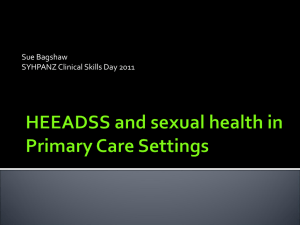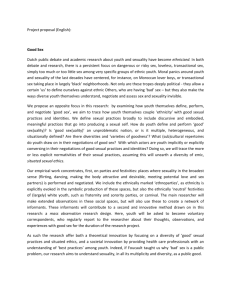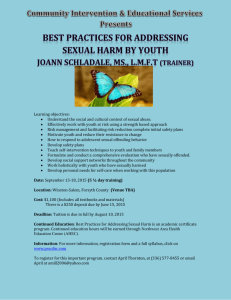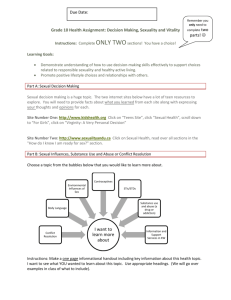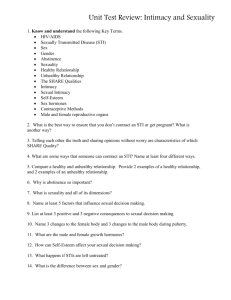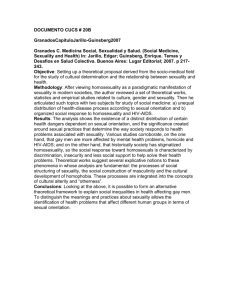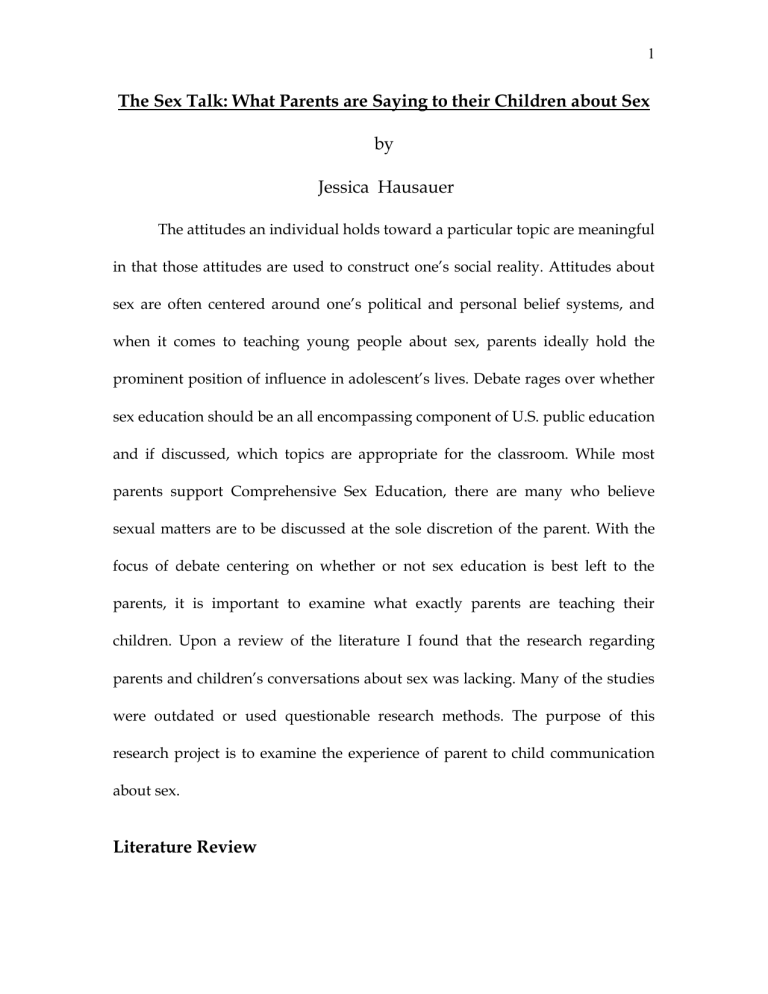
1
The Sex Talk: What Parents are Saying to their Children about Sex
by
Jessica Hausauer
The attitudes an individual holds toward a particular topic are meaningful
in that those attitudes are used to construct one’s social reality. Attitudes about
sex are often centered around one’s political and personal belief systems, and
when it comes to teaching young people about sex, parents ideally hold the
prominent position of influence in adolescent’s lives. Debate rages over whether
sex education should be an all encompassing component of U.S. public education
and if discussed, which topics are appropriate for the classroom. While most
parents support Comprehensive Sex Education, there are many who believe
sexual matters are to be discussed at the sole discretion of the parent. With the
focus of debate centering on whether or not sex education is best left to the
parents, it is important to examine what exactly parents are teaching their
children. Upon a review of the literature I found that the research regarding
parents and children’s conversations about sex was lacking. Many of the studies
were outdated or used questionable research methods. The purpose of this
research project is to examine the experience of parent to child communication
about sex.
Literature Review
2
The idea that knowledge has a direct impact on behavior faces a serious
challenge when presented in the context of sex education. Much debate has
centered on the efficacy of sex education programs in the U.S. as teen pregnancy,
abortion, and STD rates continue to soar in spite of efforts to curb these negative
trends. This debate is fueled by a societal shift in expectation relative to the
purpose of sex education. Before the AIDS crisis and skyrocketing pregnancy
rates of the 1980’s, sex education’s main goal was to facilitate open and honest
discussion with adolescents regarding their sexual health. Today, these programs
are expected to change behaviors, which may not be a reasonable goal. Further
conflict surrounds the disparity between belief and practice in relation to the
content of sex education programs. Current trends point to increased funding for
abstinence-only programs in spite of research that shows a majority of parents
and teachers support comprehensive sex education. As current research
examines these conflicts and contradictions, one may determine that the goals
and methods of sex education need to be reassessed.
School Based Sex Education
School based sex education programs are important to examine as AIDS,
teen pregnancy, and the proliferation of STD’s remains a huge problem among
our nation’s young people. Youth need to be given information that is accurate
and relative to the state of our society in order to lead healthy lives.
Unfortunately, Comprehensive Sex Education programs in the United States face
a multitude of challenges. One of these challenges is determining the content of
3
sex education in the midst of a pointed campaign by abstinence-only proponents.
Further challenges lie in determining the appropriate age for the advent of sex
education, and providing quality instruction in sexual health matters.
Content
Several studies have examined the relationship between what parents and
educators want their children to learn and what is actually being taught in our
nation’s schools. Evaluations of program content highlight the fact that a vast
majority of parents and educators want their children to learn about condoms
and contraception (Wilson 2000, Darroch 2003, Donovan 1998). However,
abstinence-only programs are generally prohibited from speaking of such topics,
or they only mention them in terms of failure rates (Darroch 2003). This lack of
positive discussion about contraception prompts some analysts to argue that
teens will be less likely to use condoms when they do become sexually active
(Jemmott 1998, Darroch 2003). In schools where more comprehensive programs
are in place, Darroch (2003) and Donovan (1998) find that educators often shy
away from controversial topics such as birth control, condoms, abortion, and
homosexuality. Wilson (2000), Donovan (1998), and Mahler (1996) explain that
teachers and administrators perceive pressure from the public to stick to an
abstinence-only agenda and do so in order to avoid controversy. While, the
research suggests that a majority of parents and educators want their children to
learn about condoms and contraception, abstinence-only programs appear to be
4
out of touch with the desires of parents and therefore, more schools should be
adapting a comprehensive approach to sex education.
Age
While most parents and educators support sex education for high school
students, some debate exists over the appropriateness of introducing information
about sex to children in grade school. While the majority isn’t quite as strong, a
significant number of sexual health educators believe that key issues regarding
sexuality should be taught in fifth and sixth grade (Darroch 2000, Kirby 1991).
Some key issues educators support include “puberty, HIV transmission,
abstinence, resisting peer pressure, teen parenthood, dating and nonsexual
affection” (Darroch 2000: 214). The results of this research suggests that parents
and teachers recognize the importance of sexual health information as a tool in
adolescent development, which should be taken into consideration when
determining the proper age for orientation to sex education.
Quality of Instruction
When analyzing sex education programs, quality of instruction constitutes
an important factor in contributing to the effectiveness of the program. Patricia
Donovan’s (1998) evaluation of the issues and challenges faced by school-based
sex education programs reports that many sex educators don’t receive adequate
training in the field of human sexuality. Donovan (1998) points out that many
school districts have no certification requirements for sexual health educators
and acknowledges that there is little incentive and little opportunity for teachers
5
to receive adequate training in this area. According to researchers, this lack of
attention to the quality of sex educators results in inaccurate and insufficient
procurement of material, as educators are more likely to stick to basic teaching
methods, such as lecturing, for fear of sparking controversial discussion or
practices (Donovan 1998, Mahler 1996, United States 2004).
In reference to strictly abstinence-only curricula, a 2004 government report
finds that many of these programs “contain false, misleading, or distorted
information about reproductive health” (United States 2004: 8). Donovan (1998)
and Darroch (2003) support these findings, while highlighting the use of scare
tactics, also common among abstinence-only curricula. Currently, the federal
government does not review or approve abstinence-only programs before
granting them funds (United States 2004), which illuminates the fact that more
needs to be done to secure the accuracy and quality of sex education programs.
Systematic evaluations of programs receiving federal funds may provide one
option for this problem.
The Effectiveness of Sex Education
Much research has been done on the effectiveness of both abstinence-only
and comprehensive sex education programs. While various studies have been
able to illustrate positive changes in behavior in relation to comprehensive sex
education, no studies have been able to establish a positive impact in relation to
abstinence-only education (Hauser 2004). However, even as positive results can
be drawn from comprehensive sex education programs, national trends in
6
adolescent sexual behavior tend to give the impression that sex education has
failed to impact our nation’s youth. When considering the results of impact on
behavior due to education, it’s important to keep in mind the limitations of such
correlation.
Comprehensive Sex Education
One of the main arguments against comprehensive sex education is that
talking about sex promotes sexual activity among young people (Berne 1995).
However, according to Kim (1982), Green (1989) and Barth ((1991), these claims
have been unfounded. In recent studies, sexual activity did not increase after
participation in comprehensive sex education programs (Berne 1995). In fact in
many cases, an increase in condom use has been linked to comprehensive sex
education, as the use of condoms has steadily increased over the past decade (
Brener 2002, Grunbaum 2004). Unfortunately, even as positive results can be
drawn from comprehensive sex education, overall trends in statistics regarding
increases in STD’s and continued prevalence of unplanned pregnancies suggests
that education alone isn’t enough to curb the risky sexual practices of this
nation’s youth. American’s may still need to refocus their goals on alternative
methods for influencing adolescent behavior.
Abstinence-Only Education
While comprehensive sex education programs have had some success in
positively affecting behavior, abstinence-only programs have not proven
themselves effective in influencing behavior (Barth 1991, Berne 2000, Darroch
7
2003, Kim 1982). In fact, according to research by Hauser (2004) some states’
evaluations of their abstinence-only programs actually showed negative
responses in behavior. As abstinence-only education programs either don’t
mention condoms at all, or only speak of them in terms of failure rates, some
argue that students take a negative view of protection and forgo its use
altogether (Jemmott 1998, Darroch 2003, Hauser 2004).
According to Berne’s (2000) analysis of studies evaluating the impact of
three widely used abstinence-only programs, little evidence existed to
substantiate claims that promoting abstinence effectively delayed onset of sexual
intercourse. Dailard (2003), Darroch (2003), and Barth (1991) all report that
approximately 50 percent of adolescents have engaged in sexual intercourse by
the age seventeen, and according to Hauser (2004), 80 percent of teens plan to be
sexually active by the age of twenty. What one may conclude from such findings
is that abstinence-only education is out of touch with the realities of adolescent
sexuality, today. Being unable to report any positive results brought about by
abstinence-only education leads one to conclude that new strategies must be
employed in order to combat the risks of adolescent sexual activity.
Social Factors Related to Sexual Behavior in Adolescents
In comparison to other developed countries, Darroch (2001) reports that
the onset and frequency of adolescent sexual activity in the United States is
relatively equal to that of other industrialized nations however, teenage
pregnancy, abortion, and STD rates are significantly higher in the United States.
8
This suggests that societal factors play a role in the sexual behaviors of
adolescents. As reported by Darroch (2001), societal attitudes toward sexuality
appear to be a bit more relaxed in Europe, and adults appear to be much more
accepting of teenage sexuality. However, attitudes toward teenage pregnancy are
much more negative in Europe than in the United States, which may account for
lower pregnancy rates (Darroch 2001).
Research Limitations
The research observed in this analysis provides one with a solid base of
information regarding issues of Comprehensive and Abstinence-Only education.
However, some limitations to this body of work must be considered. As the
majority of research methods employed by sex education studies are surveys,
most of the results represent only short term findings. Sex education research
would thus, benefit from an increase in longitudinal study. In addition, location
of study participation has a significant effect on research outcomes as attitudes
towards sex education tend to vary by region. Furthermore, the majority of
surveys were executed within a school setting, which eliminates the responses of
at risk-youth and high school dropouts. Finally, gaining access to adolescents
remains a problem as it is very difficult to gain permission to talk to adolescents
about sexual behaviors within the context of a school setting.
Future Research
While vast amounts of research have been dedicated to determining the
effectiveness of sex education programs, less research has been dedicated to
9
evaluating what students actually know. In measuring the effectiveness of
programs, researchers are mainly gathering information about adolescent
attitudes towards sex. However, little is being gained in terms of determining
what information adolescents are actually applying to their lives. For the
purpose of comparison, it may be helpful to track the level of knowledge from
the onset of sex education in adolescence, through college, and finally
parenthood. This type of research would provide important insight into what
information students, as well as parents are lacking, which may lead to needed
reassessment of current sex education practices.
As current research suggests, Comprehensive Sex Education faces many
challenges in the form of increased funding for Abstinence-Only Education and
perceived pressures felt by school administrations in maintaining conservative
approaches to sex education. However, parents and educators believe that a
comprehensive approach to sex is necessary to provide youth with the
knowledge they need to manage their sexual health, and research has shown the
benefits of such knowledge with increased condom use and positive impacts on
at-risk behaviors. While current debates center on what should be taught in our
nation’s schools, a thorough review of the literature suggests the benefits of
Comprehensive Sex Education.
Data Sources and Methods
My data for this research project was generated from seven, one hour long
interviews with parents. My overall methodology would be considered
10
hermeneutical and dialectical. I chose to conduct interviews rather than using a
survey method because I felt I would gain a better understanding of what exactly
parents are saying to their children about sex because their responses wouldn’t
be limited to a certain set of answers. Also, by engaging parents in a conversation
about sex, it was easier to evaluate the different social factors that influenced
parent/child communication about sex. I limited my sample to non-relatives, as
interviews with family members may have provided a more biased result. I
gathered interviews according to a snowball method that stemmed from
professors at a small liberal arts college in the Midwest. The sample, overall, was
fairly homogeneous being comprised of six females and one male. Similarly, six
participants were Caucasian and one participant was African American. The
majority of participants had earned Doctoral degrees and were working as
Professors, while one participant was on her third year of Bachelor’s work and
the final participant had worked at the University as a staff person for over 20
years.
From this data pool, one can begin to foster a number of assumptions. All
of the participants were in some way associated with the University, which for
some might indicate a liberal bias. In addition, the sample’s homogeneity doesn’t
allow room for generalizations based on gender, race, or class. The observations
alluded to in the discussion of this research simply focus on the fact that all of the
participants were parents and have at some point engaged their child in a
11
conversation about sex. For the purpose of further research it would be ideal to
gather a larger sample size with a more diverse population.
When it comes to the structure of the interview, the conversations were
roughly guided by a list of fifteen questions that focused on illuminating
parental attitudes toward sex, parent’s level of comfort discussing sex with their
children, and what sexual topics parent’s specifically sought to address. As a
means towards future research, it would be beneficial to triangulate the data
through a survey or perhaps, through a focus group. In addition, many of the
parents interviewed referenced particular materials that they used as resources
to both educating themselves and their children about sex. It would be beneficial
to conduct a content analysis of these materials as well.
Justification
Sex education has remained a source of constant debate over the past few
decades with conservatives, especially Christian conservatives favoring
abstinence-only
education.
The
current
administration
has
favored
a
conservative approach to addressing the issue of adolescent sexuality, as they
have dramatically increased funding for abstinence-only education and have
limited funding more progressive organizations. While the government currently
is placing an emphasis on teaching sexuality in the home, one must wonder if
parents are able to adequately complete the task. In asking parents about the
specific facts they are presenting to their children, one may find gaps in
adolescent knowledge about sexuality. Conversely, one may find that parents are
12
thoroughly engaging their children in discussions about sex. I did not interview
the children of the parents simply because that would have gone beyond the
scope of this project. However, interviewing the children would provide a
triangulation method that may be pursued in future research.
Ethics
By limiting my research subjects to adults only, I was able to avoid many
ethical concerns. As previously mentioned, I did not interview family members
in an attempt to avoid biased knowledge interfering with my observations. The
risks associated with the study were minimal. For some, talking about sex may
be embarrassing or difficult. However, this study presented no more
opportunities for embarrassment or discomfort than can be encountered in daily
life. If at any time participants felt uncomfortable, they had the option of ending
the interview or skipping a particular question. Additionally, anonymity and
confidentiality was ensured. No names were used in any resulting manuscripts,
and no other information regarding personal identity was reported in the study.
Discussion
Sex is a topic that in the United States comes cloaked in a shroud of
ambivalence. On the one hand, sex is everywhere. Americans are constantly
being bombarded with an orgy of sexual images disseminated primarily through
television, magazines, advertising, and popular music. In the public sphere, sex
represents a market strategy, a lifestyle, and for some, a fantasy. Adults and
children are forced to filter their own sexuality through a vast medium of
influence that stretches far beyond the safe walls and comfort of one’s own
home. It’s no surprise then that at the same time sex is seeping deeper and
deeper into our culture, many would hold deep reservations about the affects
that sex might have on shaping and influencing the development of our nation’s
children. For the most part, parents recognize the importance of discussing sex
and sexuality with their children. For many parents, teaching their children
13
about sex is one of the most important discussions they can have. The
importance of the discussion lies in the fact that the way Americans think about
sex and sexuality has much more to do with personal values, morals, and politics
than it has to do with simply knowing which body parts do what and how the
baby got into mommy’s tummy. Sex is inherently linked to our personal views
on marriage, gender, and the roles that women and men should play in society.
When talking to parents, it becomes clear that it’s these complexities that make
parent to child communication about sex so difficult.
Negotiating Realities and Setting Standards
It would be easy to boil the debate over sex education down to the sexual
conservatives who recognize only married, heterosexual sex as the acceptable
standard for human activity and the sexual liberals who believe that more than
one type of sexual behavior is acceptable as long as such behaviors are both
consensual and enjoyed by both parties. However, when it comes to the topic of
sex education the attitudes of parents present a more complicated picture in
which moral systems are negotiated between realities of adolescent sexual
behavior and what parents hope they can contribute to their child’s sexual
development. This point can be best demonstrated by examining the basic
standards of sexual activity that parents set forth for children.
Negotiating Realities and Setting Standards
While abstinence-only sex education dictates that only sex within the
confines of marriage is acceptable, most parents seem to acknowledge a reality in
which teenagers are likely to experiment and engage in sexual behaviors long
before they get married. Holding to the ideal of abstinence until marriage is no
longer practical as one participant states, “I think the abstinence thing is foolish. I
mean I think that’s just burying their head in the sand.” What the parents in this
study have come to realize is that there has been a cultural shift in expectation
regarding adolescent sexual activity. This point is highlighted nicely by one of
the participants as he explains:
When you achieve puberty your hormones start telling you that you should start having sexual
behavior, but adolescence isn’t over until at least from our Western culture until you are out there
and taking care of yourself. But in our culture because we now require so much schooling, what
has happened over the years is that puberty and adulthood are getting further and further apart.
Here you have an individual whose body is telling them they are ready for sex but whose culture
is telling them no you are still a child. You are not mature. You are not ready. You can’t take care
of yourself, and you can’t take care of a family, so you should abstain. But that is part of the
reason why it doesn’t work because you have some individuals who are just lock stead into
teaching abstinence, and that’s nice to teach, but that’s not always going to work because
individuals are culturing what their biological drives are telling them to do, so you have to do
more than just telling them to abstain.
When marriage is no longer the objective standard for sexual activity then
parents must look to other measures to determine when it is appropriate for their
children to begin having sex. For some this means looking toward the individual
maturity level of the child. One woman describes a level of maturity in which the
14
child exhibits, “the ability to take precautions and accept the consequences” as a
positive indication that the child is ready for sex. Kristen Luker, in When Sex
Goes to School echoes this concept as she explains that, “Before, young people
were “prepared to have sex when they were married or possibly engaged. Now,
they are “ready” when they are prepared to manage risks actively on their own
behalf and that of their partners” (Luker 2006:86). When it comes to the specifics
about the risks associated with sex and how to manage them, all of the parents
strongly agreed that the schools should take an active role in providing the facts
about sex. In this way parents tend to view school based sex education as
supplementary to the values based messages parents would like to focus on at
home. Realistically, most parents don’t have the time or energy to consistently be
researching and updating their wealth of sexual knowledge. When the schools
do a good job of teaching about sex, parents can focus on discussing emotions
and values. As one woman explained,
I think it’s real important that the schools talk about all the different options for birth control and
give some information for kids about how to access birth control including, you know, Planned
Parenthood, hot lines and things like that. I think that’s real important so that they have
information that might be different, so that I don’t have to go into all that depth and also so that if
they do have questions and don’t feel comfortable coming to me that they have somebody else
they can talk to.
For some parents, school based sex education is welcomed as a way to
“take the pressure off.” This relief is beneficial because no matter how open or
comfortable parents believe they can be when it comes to sex, most people have
their own hang ups when it comes to this topic. Each parent I interviewed had
some aspect of sex that they either displayed discomfort in talking about with
their children or failed to address because it didn’t come up in conversation. For
example, one woman felt oral sex was too explicit to be discussed, while for
another condoms and specifically explaining how to use them was too risqué.
Interestingly, however, none of the parents objected to these topics being
discussed in school. In fact, when it comes to school based sex education the
majority of parents supported expanding programs to encompass even broader
aspects of sexuality such as homosexuality and pornography.
New Challenges and the Call for Expansion
While it may not be surprising that all of the parents agreed that children
need factual information about sexual health and methods of protection, it may
be interesting to note that all of the parents agreed that issues such as
homosexuality, pornography, sexual assault, and domestic violence should hold
a place not only within discussions at home, but also in the schools. Each of these
topics presents an interesting challenge for families and educators because they
are so relevant to our times and because they often hit so close to home.
As the topic of homosexuality continues to be politicized and let out of the
closet so to speak, most parents recognize the importance of addressing this issue
in terms of acceptance and diversity. When asked how one might incorporate a
15
discussion about homosexuality in a sex education class one woman answered
with:
I guess if I were teaching a class like that to adolescents I might invite people in who are willing
to talk about their own experiences. Especially younger people who may be homosexual and are
willing to talk to other kids. I might try to do that education through statistics on a variety of
types of relationships that people use in media representations or whatever to encourage
knowledge and the realization that outside of this community there is a huge variety of people
with respect to a lot of things including sexuality.
Often the issue of homosexuality comes up at home because many people know
someone who is homosexual, which provides the opportunity for the topic to be
addressed. When asked whether they had discussed homosexuality with their
children one participant answered:
Yeah. I think if you just talk about it as part of sexuality in terms of feelings and choices. It came
up pretty directly with my daughter in terms of she had a friend who was really struggling with
sexuality issues and you know, we have friends who are homosexual and the kids have always
known. We’ve taken family vacations with a lesbian couple, so I think that they see it as
something that is not necessarily taboo.
Another relatively new challenge facing parents that also hits close to
home is the topic of pornography. Several parents, especially those with sons,
spoke to the fact that in an age of increasing technology and access to sexually
explicit material, addressing the topic of pornography is necessary because
children are viewing it, and parents want to be sure that they understand the
messages implicit in such images. One woman explained her experience in
dealing with her son and pornography:
We have really struggled with it. I don’t know exactly what to do because I know my son has
been caught on occasion looking at stuff on the internet and I don’t know if its better to close that
off and say no therefore, making it more desirable or if it’s just curiosity. I’m not sure what to do
about that so we keep him more active doing other things. The discourse with boys is so
interesting because there are all these labels for women and judging women and things like that
so we’ve had to really talk about it, and it’s been funny because his dad, bless his heart, my
husband is really having to think about the way he thinks about things and you know
objectifying and all that, too because he doesn’t want to pass those bad images on to his son, so
it’s kind of an open discourse at our house right now and that’s something we’re working
through.
The topic of pornography is interesting because it brings attention to an issue
that often gets overlooked within the general contexts of sex education, and it
also highlights the gendered differences that present themselves when
examining parent to child communications about sex.
Gendered Messages
As pornography is an issue that would likely manifest itself in discussions
with teenage boys, conversations with teenage girls tend to follow along the lines
of protection. When it comes to daughters, parents in this study at least, seemed
to focus on issues such as pregnancy, the emotional aspects of sexuality such as
being in a healthy relationship, and making sure that girls know what to do to
16
protect themselves from domestic violence and sexual assault. Furthermore, with
daughters, discussions about sex seemed to occur more frequently because
daughters were more likely to ask questions.
With sons, the sex talk seemed to be a bit more difficult as one woman
explained,
I guess I didn’t talk as frankly with my son. My husband talked to my son more. I think I would
approach it differently with a boy. I would talk more about sexual responsibility. With my son,
he wasn’t as open to ask questions. The talks were more intentional.
When parents do talk to their sons they tend to focus on expectations and
making sure their sons know about the consequences of getting a girl pregnant.
However, each of the parents that had a son agreed that perhaps more could be
done to combat the double standard that exists when it comes to sexual behavior.
One participant spoke to this standard as he explained:
We should have more emphasis on male behavior because unless you educate males then it’s not
going to work. Because educating females and telling them that they shouldn’t and then they go
out with males who pressure them into doing it because they are uneducated, then you can’t
blame the females alone. But that’s exactly what we tend to do. You can educate females and tell
them they shouldn’t engage in sexual behavior but we don’t emphasize as much with boys. On
many occasions you hear parents saying oh, boys will be boys, but they never say girls will be
girls when it comes to sexual behavior. And boys will be boys, but if they have a daughter they
don’t want the daughter to have premarital sex or be promiscuous, so if boys will be boys who
will they be boys with? That’s the question. It’s a double standard that we have…
One of the prevailing factors in why more of the attention is focused on
girls when it comes to talking about sex is the fact that with increased access to
reproductive options such as birth control and abortion, much of the burden of
sexual responsibility has shifted to the shoulders of women. As sociologist
Kristen Luker explains, “When marriage and parenthood became choices for
women, they also became choices for men. Men who want to sleep with you no
longer have to promise to take care of you “if something happens.” Before, men
carried condoms and the young man took responsibility for preventing
pregnancy. Now, since effective contraception usually means contraceptive
methods used by women, the decision to use contraception increasingly has
become the woman’s responsibility. When it comes to legal abortion, men
increasingly feel that they do not have to support what is now seen as a personal
choice” (Luker 2006: 80-81). With so much attention being focused on making
sure young women know how to protect themselves, it’s clear that young men
are missing out on important messages along the way. If parents would focus as
much attention on educating young men about the risks and responsibilities of
sex as they do young girls, perhaps some of the negative consequences of sex
could be avoided.
Conclusion
17
Sex represents a complicated and broad issue in which physical health,
emotional well-being, and personal pleasure is at stake. It’s no doubt that when
faced with the task of teaching one’s child about sex, most parents struggle to
find a healthy balance between providing open, honest, and comprehensive
information about sex while at the same time lacing their messages in a value
based structure so that their children will be able to make healthy and informed
choices with some moral guidance. While parents generally don’t want the
schools to take a stand on what is right and wrong, the parents in this study all
supported in depth information regarding sex and sexuality being taught in
schools in addition to the discussions that they have at home.
The parents in this study seemed to be negotiating between a cultural
reality in which they recognize that children are most likely going to become
sexually active in adolescence and that teenagers may not always feel
comfortable talking to their parents about everything when it comes to sex.
Similarly, parents don’t always feel comfortable discussing all sexual topics,
which makes school based sex education a valuable partner in preparing
teenagers for when they do become sexually active.
Issues such as homosexuality and pornography offer new challenges to
parents when discussing broader based themes regarding sexuality, and for the
most part, parents would be in favor of the schools providing some assistance in
addressing these topics. Additionally, parents seemed to recognize that the sex
talk is different for boys and girls and this difference is something that many of
them feel needs to be addressed.
The findings in this study only begin to scratch the surface when it comes
to learning about what parents are teaching their children about sex. A larger
and more diverse sample size would add depth and perhaps variation to these
research findings and a key component to understanding parent to child
communication about sex would be finding out what children are actually
getting from such conversations. Perhaps the results from this study will lead to
future research endeavors.
Works Cited
18
Barth, Richard P., Joyce V. Fetro, Douglas Kirby, Nancy Leland. 1991. “Reducing
the Risk: Impact of a New Curriculum on Sexual Risk-Taking”, Family
Planning Perspectives 23: 253-263.
Berne, Linda A., Barbara K. Huberman. 1995. “Sexuality Education”, Phi Delta
Kappan77: 229-233.
Brener, N. 2002. “Trends in Sexual Risk Behaviors Among High School StudentsUnitedStates, 1991-2001”, Morbidity and Mortality Weekley Report 51: 856859.
Dailard, C. 2003. “Marriage is No Immunity from Problems with Unplanned
Pregnancies”, The Guttmacher Report on Public Policy 6: 10-13.
Darroch, Jacqueline E., David J. Landry, Susheela Singh. 2000. “Sexuality
Education in Fifth and Sixth Grades in U.S. Public Schools, 1999”, Family
Planning Perspectives 32: 212-219.
Darroch, Jacqueline E., Jennifer J. Frost, Susheela Singh, and the Study Team.
2001.“Difference in Teenage Pregnancy Rates Among Five Developed
Countries:The Rules of Sexual Activity and Contraceptive Use”, Family
Planning Perspectives 33: 244-250 & 281.
Darroch, Jacqueline E., Jenny Higgins, David J. Landry, Susheela Singh. 2003.
FactorsAssociated with the Content of Sex Education in U.S. Public
Secondary Schools”, Perspectives on Sexual and Reproductive Health 35: 261269.
Donovan, Patricia. 1998. “School-Based Sexuality Education: The Issues and
Challenges”, Family Planning Perspectives 30: 188-193.
Green, Shelley K., Donna L. Sollie. 1989. “Long-Term Effects of a ChurchBased Sex Education Program on Adolescent Communication”,
Family Relations 38: 152-156.
Grunbaurn, J. 2004. “ Youth Risk Behaviors Surveillance, United States, 2003”,
Morbidity and Mortality Weekly Report 55: SS-2.
Hauser, Debra. 2004 “Five Years of Abstinence-Only-Until-Marriage Education:
Assessing the Impact,” Advocates for Youth 1-20.
Jemmott, J.B., L.S. Jemmott, G.T. Fong. 1998. “Abstinence and Safer Sex”,
Journal of the American Medical Association 279: 1529-1536.
19
Kim, Young J., Melvin Zelnik. 1982. “Sex Education and Its Association With
Teenage Sexual Activity, Pregnancy and Contraceptive Use”, Family
Planning Perspectives 14: 117-119+123-126.
Kirby, D. 1991. “Reducing the Risk: A New Curriculum to Prevent Sexual Risk
Taking”, Family Planning Perspectives 23: 253-263.
Luker, Kristen. 2006. When Sex Goes to School. N.Y.: W.W. Norton and Company.
Mahler, Karen. 1996. “Condom Availability in the Schools: Lessons from the
Courtroom”, Family Planning Perspectives 28: 75-77.
United States House of Representatives, Committee on Government ReformMinority Staff, Special Investigations Division, Prepared for Henry A.
Waxman. The Content of Federally Funded Abstinence-Only Education
Programs, December 2004.
Wilson, Susan N. 2000. “Sexuality Education: Our Current Status, and an Agenda
For 2010”, Family Planning Perspectives 32: 252-254.

